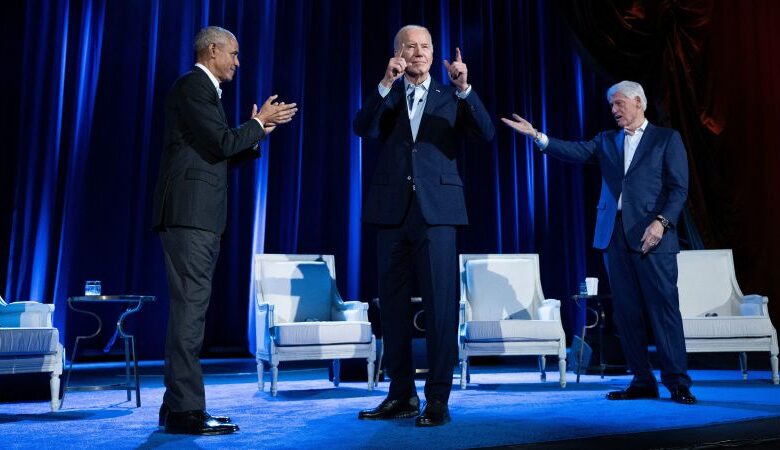Inside Biden’s 2024 campaign media strategy that bypasses the Beltway press

Editor’s Note: A version of this article first appeared in the “Reliable Sources” newsletter. Sign up for the daily digest chronicling the evolving media landscape here.
During his trip to New York City last week, President Joe Biden sat down for a rare joint interview alongside former presidents Bill Clinton and Barack Obama.
But the interview, which received significant attention, was not with a national news organization. Neither was it with a local newspaper or outlet. It was with the comedy podcast, “Smartless,” hosted by the actors Jason Bateman, Sean Hayes, and Will Arnett.
The decision to speak with the Hollywood trio, while jilting the traditional press in the process, is emblematic of Biden’s media strategy as he faces a high-stakes reelection with democracy itself on the line. While a caricature has been painted of the president holed up in the White House dodging the media spotlight, he is actually participating in a fair share of interviews — just not with the Beltway press.
In fact, Biden has engaged in a number of interviews this year, particularly with the Black and Hispanic press. Facing sagging poll numbers with Black Americans, Biden has granted at least 10 interviews with media outlets reaching the community this year, most of them with local radio stations during the drive time hours. Biden has also participated in two interviews with Hispanic radio outlets in 2024 and is set to sit down with Univision’s Enrique Acevedo this week, Adrian Carrasquillo reported Monday for Vanity Fair.
“People in D.C. and New York may not always see it,” Michael Tyler, the Biden campaign communications director, told me by phone. “But you know who is seeing it? The voters we are trying to reach.”
Tyler said that the Biden campaign is prioritizing interviews with outlets reaching specific constituency groups, believing that focusing on local media will pay off in November. Tyler, who pushed back against the notion that Biden is avoiding the traditional press, said that putting their energy into outlets with targeted reach is one component of a savvy communications strategy. The campaign argues that it adds up to media playbook that is inclusive of new media entities and other platforms with broad reach.
“Our North Star as a campaign is to make sure the president is to be in direct communication with the voters who will decide the pathway to the 270 electoral votes,” Tyler explained.
But as Biden pays more attention to new and non-traditional forms of media, he has shown more reluctance than his predecessors to grant one-on-one sit-down interviews with the national press, participating in fewer interviews than other presidents at this point in his presidency. Most recently, Biden opted to skip the traditional pre-Super Bowl interview for the second consecutive year, raising questions about his decision to not speak to the country’s largest assembled audience.
“Number of times Jason Bateman has done a sit-down interview with President Biden: 2. Nearly every print reporter who covers the White House: 0,” Jennifer Haberkorn, a White House reporter for POLITICO, noted on X after Biden’s “Smartless” interview.
Some of Biden’s hesitation to speak with the traditional news media likely stems from his frustration with how members of the press have covered him and his campaign. The Biden White House and campaign have sharply criticized how the press has covered everything from Special Counsel Robert Hur’s report to the president’s age, devoting what they believe to be a disproportionate amount of coverage to the issues even as Donald Trump rages against the country’s institutions and pushes poisonous election lies.
But it goes without saying that interviews with the national news media are where Biden will face the toughest line of questioning on the 2024 campaign, domestic policy, and foreign affairs, with a level of scrutiny and accountability typically found mostly in the D.C. press which specializes in such matters.
By bypassing the Beltway press and prioritizing other forms of media, Biden has been able to remain in contact with voters, while allowing the president to avoid being repeatedly pressed on uncomfortable topics such as his age.
“These interviews we are able to do focus far more on the substance and the stakes that matter to voters than they do to folks in the beltway and New York,” Tyler said.
Biden is by no means a pioneer of the bypass-the-Beltway strategy. Obama famously spoke to Zach Galifianakis for the “Between Two Ferns” show and Trump endlessly raged on social media to his millions of followers. That said, as the 2024 campaign reaches a crescendo, and Biden yearns to reach the largest audiences possible, participating in these targeted interviews will not be enough. Biden will likely need to sit for interviews on programs with broader reach. The strategy of bypassing the Beltway can only last for so long.
Get Best News and Web Services here







